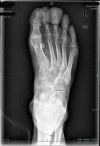A rare large cutaneous chondroid syringoma involving a toe: A case report
- PMID: 29384887
- PMCID: PMC5805459
- DOI: 10.1097/MD.0000000000009825
A rare large cutaneous chondroid syringoma involving a toe: A case report
Abstract
Rationale: Chondroid syringoma (CS) occurs mostly on the face and neck, and rarely occurs in the toe. Malignant CS is invasive, grows quickly, and has a high recurrence rate. The presence of a bilobed CS in 1 toe has never been reported in the literature.
Patient concerns: A 72-year-old male patient presented with a mass in a third toe of his right foot. The mass had slowly grown in 2 years. He felt mild pain and the mass occupied most of the tip of the toe.
Diagnoses: Radiographs showed a large soft-tissue mass in the third toe of his right foot without any bone destruction. Ultrasonogram showed 2 partly fused hypoechoic masses within the lesion. The mass was therefore diagnosed as a benign CS.
Interventions: We amputated the toe with the mass under local anesthesia. The postoperative pathohistological examinations confirmed that the lesion was a bipartite CS exhibiting active cellular proliferation.
Outcomes: Two years after surgery, there was no tumor recurrence.
Lessons: CS can also present as multiple adjacent masses. Complete surgical resection and long-term follow-up are essential.
Conflict of interest statement
Competing Interests
The authors have no conflicts of interest to disclose.
Figures






Similar articles
-
Chondroid syringoma of the hand.Scand J Plast Reconstr Surg Hand Surg. 2002;36(6):379-81. doi: 10.1080/028443102321096401. Scand J Plast Reconstr Surg Hand Surg. 2002. PMID: 12564820
-
Chondroid syringoma: case report of a highly unusual foot tumor.Foot Ankle Int. 2010 Apr;31(4):333-5. doi: 10.3113/FAI.2010.0333. Foot Ankle Int. 2010. PMID: 20371021 No abstract available.
-
Atypical Chondroid Syringoma of the Toe.J Am Podiatr Med Assoc. 2023 May-Jun;113(3):22-094. doi: 10.7547/22-094. J Am Podiatr Med Assoc. 2023. PMID: 37463189
-
Recurrent malignant chondroid syringoma of the foot: a case report and review of the literature.Am J Clin Oncol. 2000 Jun;23(3):227-32. doi: 10.1097/00000421-200006000-00003. Am J Clin Oncol. 2000. PMID: 10857882 Review.
-
Chondroid syringoma: case report and review of the literature.Dermatol Online J. 2006 Sep 8;12(5):8. Dermatol Online J. 2006. PMID: 16962023 Review.
Cited by
-
Mixed Eccrine Cutaneous Tumor with Folliculo-Sebaceous Differentiation: Case Report and Literature Review.Medicina (Kaunas). 2023 Aug 16;59(8):1465. doi: 10.3390/medicina59081465. Medicina (Kaunas). 2023. PMID: 37629755 Free PMC article. Review.
-
The Role of Radiation Therapy as an Adjuvant Treatment in Nodal Metastasis of Malignant Chondroid Syringoma.Cureus. 2020 Nov 6;12(11):e11360. doi: 10.7759/cureus.11360. Cureus. 2020. PMID: 33304693 Free PMC article.
References
-
- Yavuzer R, Başterzi Y, Sari A, et al. Chondroid syringoma: a diagnosis more frequent than expected. Dermatol Surg 2003;29:179–81. - PubMed
-
- Metzler G, Schaumburg-Lever G, Hornstein O, et al. Malignant chondroid syringoma: immunohistopathology. Am J Dermatopathol 1996;18:83–9. - PubMed
-
- Chen AH, Moreano EH, Houston B, et al. Chondroid syringoma of the head and neck: clinical management and literature review. Ear Nose Throat J 1996;75:104–8. - PubMed
-
- Mathiasen RA, Rasgon BM, Rumore G. Malignant chondroid syringoma of the face: a first reported case. Otolaryngol Head Neck Surg 2005;133:305–7. - PubMed
-
- Hirsch P, Helwig EB. Chondroid syringoma. Mixed tumor of skin, salivary gland type. Arch Dermatol 1961;84:835–47. - PubMed
Publication types
MeSH terms
LinkOut - more resources
Full Text Sources
Other Literature Sources

